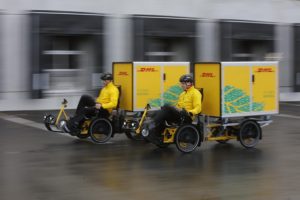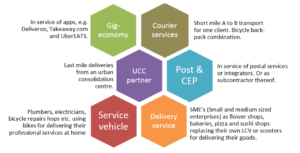The impact of urban mobility, and urban freight transport in particular, on the liveability of an urban area is elevated. Growing urban road congestion in most European cities, to which urban freight transport is an active contributor, vehicle emissions and road safety are big challenges for society.
Also Belgian cities realised a steep growth of population in urban areas. These challenges lead to stakeholders identifying urban liveability challenges and protesting there against.
Ambitious European transport and environmental policies increased pressure on stakeholders to ameliorate vehicle efficiency, innovate and become more sustainable in their day to day business. One of the solutions is urban freight transport by cargo bicycles.
Cargo bikes
The central research question for Ph.D. Jochen Maes (University of Antwerp in Belgium) was: “Can cargo bicycles contribute to an enhanced economic/environmental/societal liveability of urban areas, and to what extent?” Cargo bicycle transport is nowadays organised via various start-ups.
New cargo bikes with electric assistance and IT developments allow new business models to flourish (examples are Deliveroo and Bubble Post). Long lasting bike couriers stay strong in niche markets (e.g. Pedal BXL). And long-existing global transport organisations (like TNT Express, UPS and DHL) develop own cargo bicycle transport solutions.
Courier, express and parcel
The Ph.D. provides insight in the applicability of cargo bicycles for CEP (courier, express and parcel) transport in urban areas. CEP transport grows at a past pace, following a boom in e-commerce sales. A literature overview on cargo bicycle transport is defining (economic) research gaps.
Own research on the Belgian market is used to develop a market analysis, which fuels the development of a transport cost simulation model. This simulation leads to research-based conclusions on the business- and welfare economic benefits of an increased cargo bicycle use in Belgian cities. The model is also used for a sensitivity analysis on key cost parameters. Policy approaches for stimulating cargo bicycle uptake are simulated. Conclusions on the market developments and on policy options conclude the Ph.D.


